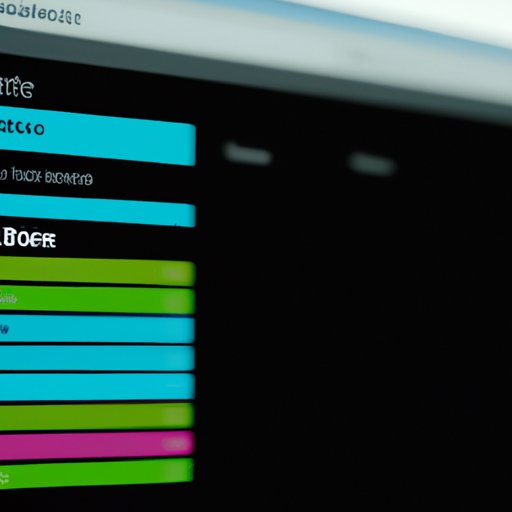Introduction
Adobe After Effects and Adobe Illustrator are two of the most popular pieces of software in the world of graphic design. They both have their own unique uses, but when combined they can create powerful visuals that are hard to achieve with either one alone. For example, an AI file can be used as a vector graphic in After Effects, allowing for more creative control and flexibility than using a rasterized graphic. This article will explore the various ways you can import an AI file into After Effects and provide step-by-step instructions and troubleshooting tips for each method.
Utilizing After Effects’s “File > Import > File” Option
The first method of importing an AI file into After Effects is by utilizing the “File > Import > File” option. To do this, open up the “File” menu and select “Import > File…”. This will open up a window where you can browse your computer for the AI file you want to import. Once you have located the file, simply click “Open” and After Effects will begin importing it.
However, if you encounter any issues with this method, there are a few things you can try. First, make sure that the AI file is saved in a compatible format for After Effects (such as .EPS or .PDF). If it isn’t, then you may have to convert it first before importing it. Another potential issue could arise if the AI file contains multiple artboards or layers. In this case, you may need to flatten the file before importing it into After Effects.

Dragging and Dropping the AI File into After Effects
Another way to import an AI file into After Effects is to simply drag and drop it into the composition window. To do this, open up the AI file in Adobe Illustrator and select the artwork you want to use. Then, simply drag the artwork from the Illustrator window into the After Effects window. This should automatically add it to the composition timeline.
If you encounter any issues with this method, the main thing to check is whether or not the artwork is in a compatible format for After Effects. As with the previous method, if it isn’t, then you may have to convert it first before dragging and dropping it into the composition window.

Using Adobe Bridge to Import AI Files into After Effects
Adobe Bridge is a great tool for managing and organizing your artwork. You can also use it to quickly import AI files into After Effects. To do this, open up Adobe Bridge and locate the AI file you want to import. Then, simply drag and drop the file into the After Effects composition window.
If you encounter any issues with this method, the main thing to check is that the AI file is in a compatible format for After Effects. Additionally, you may need to flatten the file before importing it into After Effects.
Converting AI Files to a Compatible Format in Illustrator
If you have an AI file that is not in a compatible format for After Effects, then you can use Adobe Illustrator to convert it. To do this, open up the AI file in Illustrator and select the artwork you want to use. Then, go to “File > Save As…” and select a compatible format such as EPS or PDF. Once you save the file, you can then import it into After Effects.
If you encounter any issues with this method, the main thing to check is that the AI file is in a compatible format for After Effects. Additionally, you may need to flatten the file before saving it in a compatible format.
Using the After Effects Script: AI to AE
The After Effects script AI to AE is a great way to quickly import AI files into After Effects. To do this, simply open up the script in After Effects and select the AI file you want to import. The script will automatically import the file into After Effects and add it to the composition timeline.
If you encounter any issues with this method, the main thing to check is that the AI file is in a compatible format for After Effects. Additionally, you may need to flatten the file before importing it into After Effects.
Importing AI Files as Comps in After Effects
Another way to import AI files into After Effects is to use them as compositions. To do this, open up the AI file in Adobe Illustrator and select the artwork you want to use. Then, go to “File > Export > Composition…” and select a compatible format such as EPS or PDF. Once you save the file, you can then import it into After Effects.
If you encounter any issues with this method, the main thing to check is that the AI file is in a compatible format for After Effects. Additionally, you may need to flatten the file before exporting it as a composition.

Using Dynamic Link for AI Files in After Effects
Adobe Dynamic Link is a great way to quickly and easily import AI files into After Effects. To do this, open up the AI file in Adobe Illustrator and select the artwork you want to use. Then, go to “File > Adobe Dynamic Link > Import into After Effects…” and select the artwork you want to use. This will automatically import the file into After Effects and add it to the composition timeline.
If you encounter any issues with this method, the main thing to check is that the AI file is in a compatible format for After Effects. Additionally, you may need to flatten the file before importing it into After Effects.
Conclusion
In conclusion, there are a variety of ways to import Adobe Illustrator (AI) files into Adobe After Effects. Whether you’re using the “File > Import > File” option, dragging and dropping the file into the composition window, using Adobe Bridge, converting the file to a compatible format in Illustrator, using the After Effects script AI to AE, importing the file as a comp in After Effects, or using Dynamic Link, each method has its advantages and disadvantages. Hopefully this article has provided you with the information you need to successfully import AI files into After Effects.
For further help and advice, please see the following resources:
- Adobe Help: Importing
- RocketStock: Importing Illustrator Files into After Effects
- PremiumBeat: Importing Illustrator into After Effects
-
(Note: Is this article not meeting your expectations? Do you have knowledge or insights to share? Unlock new opportunities and expand your reach by joining our authors team. Click Registration to join us and share your expertise with our readers.)
